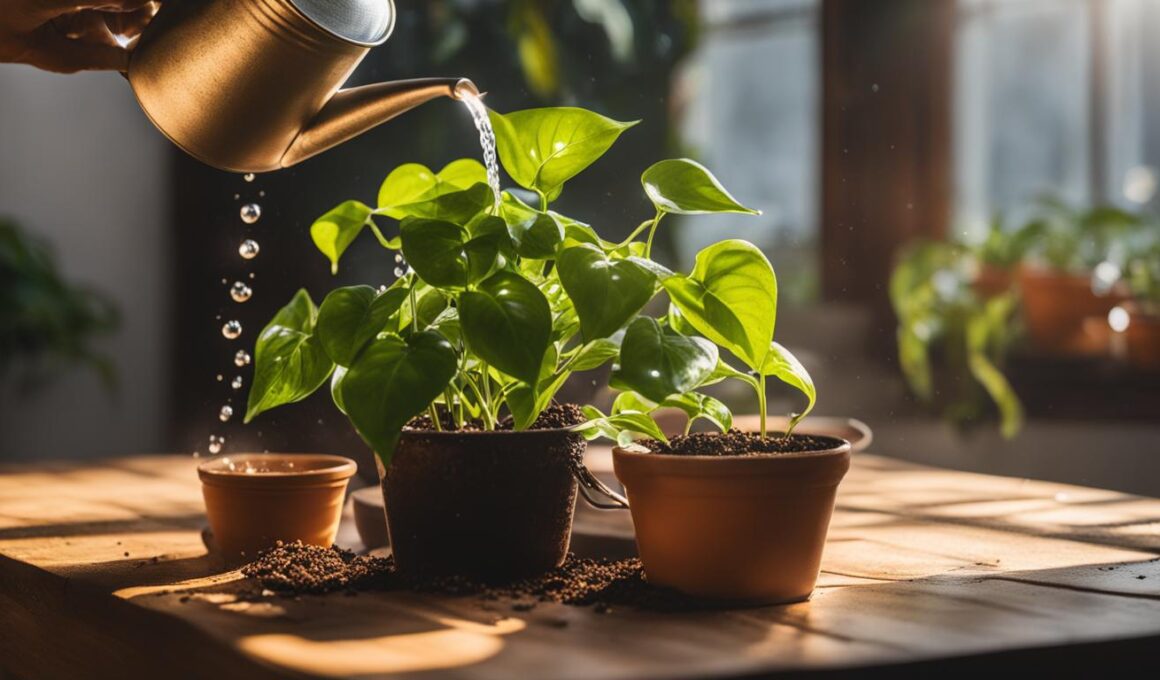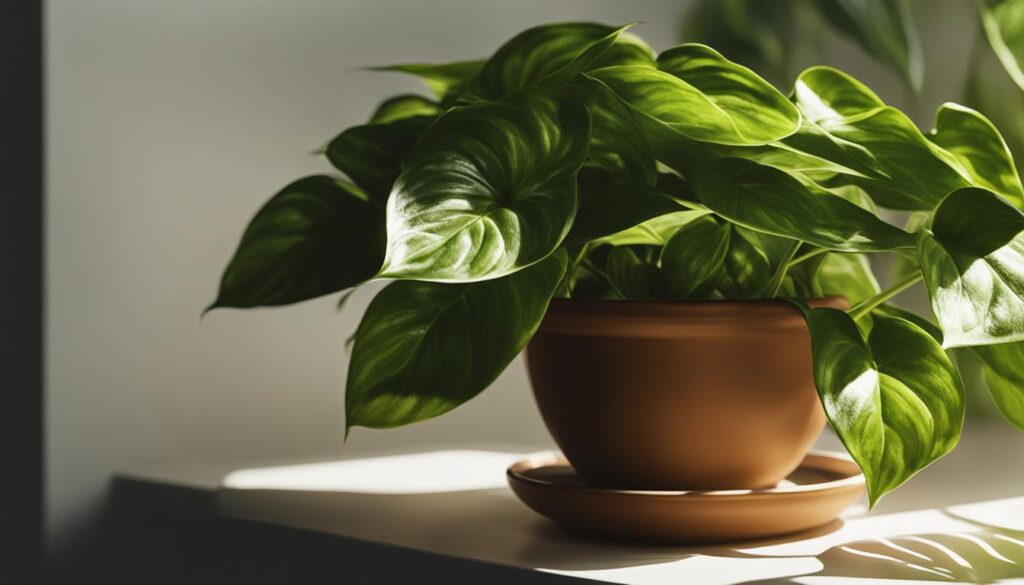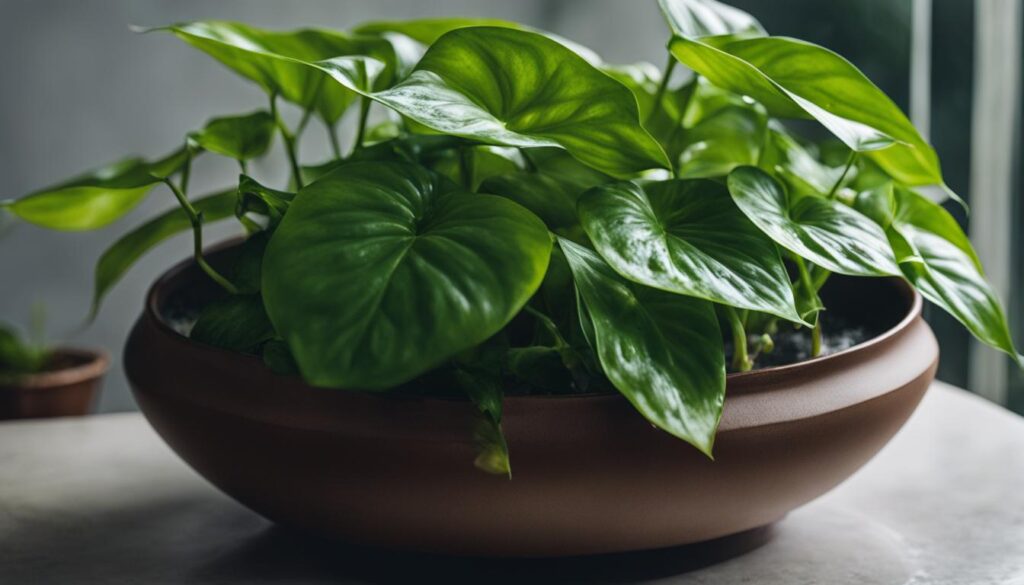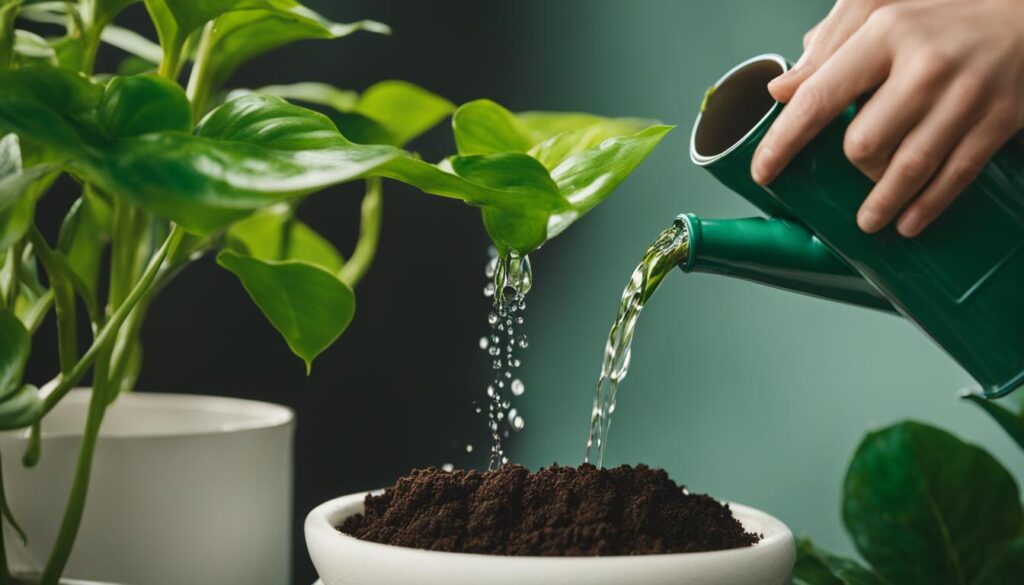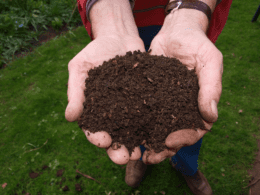The Pothos Watering Guide is designed to help you navigate the intricacies of Epipremnum aureum care efficiently. Pothos plants are popular choices for indoor plant enthusiasts due to their ease of care and ability to purify the air. Despite their low-maintenance nature, it’s essential to understand the correct Pothos plant watering frequency to ensure they thrive in your indoor plant care routine.
Key Takeaways
- Understand the importance of proper Pothos watering frequency for healthy plant growth.
- Learn how various factors, like light exposure and seasonal changes, affect watering schedules.
- Identify signs of overwatering and underwatering to maintain an optimal moisture balance.
- Discover the benefits of deep watering for Pothos plants and how to adjust your watering routine when necessary.
- Implement practical watering techniques and tools for accurately measuring soil moisture.
Understanding Pothos Watering Needs
Pothos plants are adaptable and can tolerate varying light conditions, thriving in bright indirect light but also enduring medium to low indirect light settings. Direct sunlight should be avoided to prevent leaf burn. The watering schedule is crucial for maintaining proper Pothos care, occurring every 1-2 weeks and allowing the soil to dry out between sessions. More frequent watering is necessary in brighter light, less often in lower light conditions.
Proper humidity, resembling their native tropical environment at 50-70%, and temperatures within the 65°F-85°F range are ideal for Pothos. They can grow quite large, with wild specimens reaching lengths of up to 60 feet and indoor plants reaching 10 feet. With tropical plants hydration being an essential factor in their care, understanding the correlation between light, temperature and watering frequency is vital to caring for these popular indoor plants.
| Light Intensity | Watering Frequency |
|---|---|
| Bright, Indirect | Once a week to every 10 days |
| Medium, Indirect | Every 10 to 14 days |
| Low, Indirect | Every 14 days to every 3 weeks |
The Pothos light requirements vary depending on the specific cultivar. For instance, the Golden Pothos can adapt better to lower light environments compared to its cousins, the Pothos Neon and Pothos Marble Queen, which may require more exposure to light for optimal growth.
- Golden Pothos: Medium to Low Indirect light
- Pothos Neon: Bright Indirect light
- Pothos Marble Queen: Bright Indirect light
By taking into account the specific needs of your Pothos plant, particularly its watering and light requirements, you can ensure a healthy and thriving plant in your indoor garden.
Essential Factors Affecting Watering Frequency
Understanding the essential factors that affect Pothos watering frequency can help ensure the plant thrives in its indoor environment. The most important factors include light exposure, soil composition, and seasonal adjustments.
Light Exposure and Its Impact on Hydration
Pothos light exposure greatly influences the plant’s watering needs. Plants situated in south-facing rooms or under grow lights require more frequent watering due to higher light intensity, whereas those in less lit areas need to be watered less frequently. The following table summarizes the ideal watering frequency based on indoor plant lighting conditions:
| Lighting Condition | Watering Frequency |
|---|---|
| Bright, indirect light | Every 7-10 days |
| Medium, indirect light | Every 10-14 days |
| Low, indirect light | Every 14-21 days |
Soil Composition and Drainage Considerations
The health and well-being of Pothos plants are contingent on proper soil composition. A well-drained soil mix, consisting of perlite, vermiculite, coco coir, or peat moss, is crucial to ensure that water moves through the soil swiftly enough to prevent water-logging and root rot. A comprehensive Pothos soil composition not only improves drainage but also supports better plant hydration levels.
Seasonal Adjustments for Optimal Watering
Seasonal changes demand adjustments to watering routines. Higher temperatures and increased light during summer lead to more frequent watering needs. Conversely, during the dormant fall and winter seasons, reduced sunlight and cooler temperatures necessitate a decrease in watering frequency.
- Summer: Increase watering frequency due to higher temperatures and light exposure.
- Fall and Winter: Decrease watering frequency as less sunlight and cooler temperatures reduce evaporation rates and plant hydration needs.
In conclusion, by taking into account factors like Pothos light exposure, soil composition, and seasonal variations, you can ensure optimal watering frequency and help your Pothos plant thrive in its indoor environment.
Maintaining the Perfect Balance: Signs of Over and Underwatering
It is crucial for gardeners to maintain the right moisture balance for their Pothos plants. This can be achieved by identifying overwatering symptoms and underwatering signs promptly. When it comes to Pothos plant health, understanding the signals your plant is sending will help you avoid unnecessary stress on your beloved foliage.
- Yellowing leaves
- Black stems
- Soft brown leaf spots
Underwatered Pothos plants, on the other hand, show these signs:
- Wilted, limp leaves
- Dry potting mix
By quickly recognizing these indicators, you can take the necessary steps to adjust your watering frequency and ensure the ongoing health of your Pothos plant.
| Overwatering Symptoms | Underwatering Signs |
|---|---|
| Yellowing leaves | Wilted, limp leaves |
| Black stems | Dry potting mix |
| Soft brown leaf spots | — |
When adjusting your watering routine, pay close attention to the symptoms and signs described above. With regular monitoring and proper care, you can maintain a healthy moisture balance for your Pothos plant and enjoy its beauty and air-purifying benefits for years to come.
Practical Watering Techniques for Pothos Care
Proper hydration is essential for maintaining a healthy Pothos plant. In this section, we will explore different watering techniques, tools for measuring soil moisture, and tips for adjusting your watering schedule to optimize your plant’s growth and health.
Deep Watering vs. Frequent Sips: What Works Best?
The deep watering method is highly recommended for Pothos plants. This technique involves thoroughly soaking the soil, ensuring that water reaches the roots and providing plants with the hydration they need. In contrast, small, frequent waterings or “sips” can result in uneven moisture distribution, potentially harming plant root systems.
To achieve proper plant hydration, follow these simple steps:
- Water your Pothos until excess drains freely from the bottom of the pot.
- Allow the soil to dry between waterings, as continuous wet soil can lead to root rot.
- Keep an eye on the plant and its surroundings, adjusting your watering schedule as needed based on factors like light exposure and season.
Tools and Tips for Measuring Soil Moisture
To avoid over or underwatering your Pothos, keeping an eye on soil moisture is crucial. There are several techniques and tools you can use for accurate measurements:
- Finger test: To perform this simple technique, insert your finger into the soil to a depth of 1-2 inches (2.5-5 cm). If the soil feels dry, it’s time to water the plant.
- Chopstick or skewer: Insert a wooden chopstick or skewer into the soil and leave it for a few minutes. If the chopstick comes out mostly dry, it’s time to water. If it’s damp, wait a day or two before rechecking.
When to Adjust Your Watering Routine
Numerous factors affect your Pothos watering schedule, making adjustments necessary. Keep an eye on the following variables:
- Light exposure: Pothos plants situated in brighter areas require more frequent watering than those in less lit environments.
- Seasonal changes: Warmer temperatures and increased light during summer lead to higher plant hydration needs, whereas cooler temperatures and reduced sunlight during fall and winter call for less frequent watering.
- Plant growth stage: As your Pothos matures, its watering requirements may change. Monitor the plant’s appearance and stress indicators to gauge when adjustments are needed.
By incorporating these practical watering techniques and tips into your Pothos care routine, you can ensure proper plant hydration and maintain the health and growth of your beautiful houseplant.
Is the Watering Schedule for Pothos Similar to that of Hibiscus in Pots?
Conclusion
In order to enjoy a thriving Pothos plant, consistent care and thorough understanding of the environmental factors affecting its development are essential. As one of the easiest houseplants to maintain, Pothos (Epipremnum aureum) will reward you with impressive growth and air purifying capabilities once you master an effective watering strategy. Reflect upon the native habitat and seasonal needs of these versatile plants when establishing their care regimen.
Monitoring your Pothos for signs of over or under-watering is crucial to keep it in optimal health. Overwatering may result in yellowing leaves, black stems, and soft brown leaf spots, whereas underwatering can cause wilted, limp leaves, and dry potting mix. Identifying these symptoms quickly and making the necessary adjustments to your watering routine will ensure a perfectly balanced moisture level, creating the ideal environment for your Pothos to flourish.
To maintain a healthy Pothos, use proper watering techniques such as deep watering, which guarantees even soil moisture and strong root development. Utilize tools like chopsticks, skewers, or even your finger to measure soil moisture before watering your plant. Don’t shy away from modifying your watering schedule to accommodate changes in light, season, humidity, and the overall health of your Pothos. By following these houseplant care tips, your Pothos plant will become a vibrant and lively addition to your living space.





